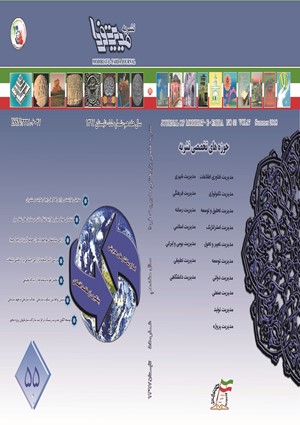Synergistic leadership, post-modern approach to human resource flexibility and voice behavior
Subject Areas :
Sead aibaghi esfehani
1
![]() ,
2
,
Ramin Elahi Elahi
3
,
2
,
Ramin Elahi Elahi
3
1 - استادیار دانشکده مهندسی صنایع و مدیریت، دانشگاه صنعتی شاهرود، ایران
2 -
3 -
Keywords: synergy synergistic leadership voice behavior human resource flexibility,
Abstract :
Nowadays, In developing countries the women's participation in senior sectors of the organizations is lower than men, thus glass ceilings and walls have limited horizontally and vertically movement of women in the organizations. The synergistic leadership theory is the post-modern approach to leadership that conceptualized the presence of women in leadership positions of the leadership of the organizations as the synergistic agent in the organizations. This study aims to evaluate the effect of synergistic leadership on flexibility of human resources, in this evaluation the effect of the voice behavior of employees is considered as a mediator variable. This study is a practical search in terms of aim and is a descriptive survey in terms of method. The realm of study is the offices of social security organizations which is located in Tehran. For doing this study for measuring synergistic leadership in organization is used through the questionnaire of synergistic leadership, Thus after validation testes, reliability and validity were approved. Data analysis is done by using regression test and structural equations through software Amos and the findings of the research show the positive effect of synergistic leadership on the flexibility of human resources and also confirmed the positive and significant effect of synergistic leadership on the voice behavior of employees.
1. اﻋﺮاﺑﯽ، ﺳﯿﺪ ﻣﺤﻤﺪ و داﻧﺶ¬ﭘﺮور، ﻣﯿﺘﺮا (1386)، اﻟﮕﻮﻫﺎي اﻧﻌﻄﺎف¬ﭘﺬﯾﺮي در ﻣﺪﯾﺮﯾﺖ ﻣﻨﺎﺑﻊ اﻧﺴﺎﻧﯽ، ﻓﺼﻠﻨﺎﻣﻪ ﻣﻄﺎﻟﻌﺎت ﻣﺪﯾﺮﯾﺖ، ﺷﻤﺎره 55، ﺻﻔﺤﺎت 1- 42.
2. آیباغی اصفهانی، سعید؛ ممویی، نهال و مرادی رفعت، میترا (1393)، ﺑﺮرﺳﻲ ﺗﺎﺛﻴﺮ رﻫﺒﺮي ﺑﺼﻴﺮ ﺑﺮ ﺷﺎدي و رﻓﺘﺎرﻫﺎي آواﻳﻲ ﻛﺎرﻛﻨﺎن (ﻣﻄﺎﻟﻌﻪ ﻣﻮردي: ﻓﻮﻻد ﻣﺒﺎرﻛﻪاﺻﻔﻬﺎن)، دوﻣﻴﻦ ﻫﻤﺎﻳﺶ ﻣﻠﻲ ﭘﮋوﻫﺶ ﻫﺎي ﻛﺎرﺑﺮدي درعلوم مدیریت و حسابداری، دانشگاه تهران.
3. Armstrong, M. (2006). Handbook of Human Resource Management Practice (10th ed.). London: Kogan Page, Limited
4. Ardovini, Joanne & Trautman, H. Diane & Brown, Genevieve. (2010), Including Female Leadership Experiences and Behaviors: A Qualitative Validation of Synergistic Leadership Theory, International Leadership Journal.
5. Bhattacharya, M., Gibson, D. E., and Doty, D. H. (2005), The Effects of Flexibility in Employee Skills, Employee Behaviors, and Human Resource Practices on Firm Performance. Journal of Management, 31, pp. 622–640
6. Bamberg, W. (2004). An application of the synergistic leadership theory to the leadership experiences of five female superintendents leading successful school districts (Doctoral dissertation, Sam Houston State University, 2004). Dissertation Abstracts International, 65(08), 2824.
7. Esfahani, S. A., Rezaii, H., Koochmeshki, N., & Parsa, S. S. (2017). Sustainable and flexible human resource management for innovative organizations. AD-minister, (30), 195-215.
8. Eisenberg, E. M., & Goodall, H. L. (2001). Organizational communication: Balancing creativity and constraint. Boston: Bedford/St. MartinS
9. Gorden, W. I. (1988). Range of Employee Voice. Employee Responsibilities & Rights. journal of Management Studies, 1(4), 283-299
10. Gambarotto, F., & Cammozzo, A. (2010). Dreams of silence: Employee voice and innovation in a public sector community of practice. Innovation: Management Policy and Practice 12, 166-178
11. Hirschman, A. O. (1970). Exit, voice and loyalty: Responses to decline in firms, organizations and states. Cambridge, MA: Harvard University Press
12. Holtkamp, L. (2001). “The validation of the organizational and leadership effectiveness inventory”, PhD dissertation, Sam Houston State University, Huntsville, TX
13. Hernandez, R. M. (2004). “An analysis of superintendent and school board perceptions of the factors of the synergistic leadership theory”, PhD dissertation, Sam Houston State University, Huntsville, TX
14. Irby, B. J., Brown, G., Duffy, J. A., & Trautman, D. (2002). The synergistic leadership theory. Journal of Educational Administration, 40(4), 304, 6, 7, 10, 12-18
15. Irby, B., Genevieve Brown, and L. Yang. "The Synergistic Leadership Theory: A 21 st Century Leadership Theory." REMEMBER OUR MISSION (2009): 93.
16. Liu, W.; Zhu, R., & Yang, Y. (2010). I warn you because I like you: Voice behavior, employee identifications, and transformational leadership. The Leadership Quarterly 21, 189202
17. Lepine, J. A., Colquitt, J. A., & Erez, A. (2000), Adaptability to changing task contexts: Effects of general cognitive ability, conscientiousness, and openness to experience. Personnel Psychology, 53: pp. 563-594
18. Milliman J, von Glinow MA, Nathan M. (1991), Organizational life cycles and strategic international human resource management in multinational companies: implications for congruence theory, Academy of Management Review;16: pp. 318–339
19. Neuman, G. A. , & Wright, J. (1999), Team effectiveness: Beyond skills and cognitive ability, Journal of Applied Psychology, 84: pp. 376-389
20. Schlosberg, T. V. (2003). “An international case study: The transportability of the synergistic leadership theory to selected educational leaders in Mexico”, PhD dissertation, Sam Houston State University, Huntsville, TX.
21. Sanchez, R. (1995), Strategic Flexibility in Product Competition, Strategic Management Journal, 16, pp. 135–159
22. Trautman, D. (2000). The validation of the synergistic leadership theory: A gender inclusive theory (Doctoral dissertation, Sam Houston State University, 2000). Dissertation Abstracts International, 62(07A), 2598.
23. Travis, D. J.; Gomez, R. J. & Mor Barak, M. E. (2011). Speaking up and stepping back: Examining the link between employee voice and job neglect. Children and Youth Services Review 33, 46-68.
24. Van Dyne, L., & LePine, J. (1998). Helping and voice extra-role behaviors: Evidence of construct and predictive validity. Academy of Management Journal, 41, 108-119
25. Van Dyne, L.; Ang, S., & Botero, I. (2003). Conceptualizing employee silence and employee voice as multidimensional constructs. Journal of management studies, 40, 1360-1392
26. Verheul, I., (2003), “Human resource management practices in female and male-led businesses”, Small Business Economics, pp.1-13.
27. Wright, P. M. , and Snell, S. A. (1998), Toward a Unifying Framework for Exploring Fit and Flexibility in Strategic Human Resource Management, Academy of Management Review, 23, pp. 756–772
28. Young-Ybarra C, Wiersema M. (1999), Strategic flexibility in information technology alliances: the influence of transaction cost economics and social exchange theory. Organization Science;10, pp. 439–59


